New York Rangers: Top 10 prospects entering 2018

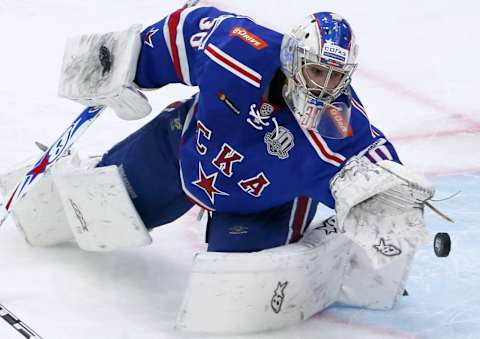
The New York Rangers are rebuilding after tearing down their roster over the last few years. Here are the prospects who can kick start that rebuild.
The New York Rangers have a ton of excellent prospects. They have so many that the following prospects, who could have made other lists, aren’t on this one: Timothy Gettinger, Ryan Lindgren, Ryan Gropp, Sean Day, Nils Lundkvist, and Ville Meskanen.
Lundkvist was a first-round pick this last draft. Day was one of the very rare players who got to play in the Canadian juniors before 16. Gropp put up 14 goals in his first AHL season. These are the guys who didn’t make the list. The Rangers have a very good start to their rebuild.
More from Puck Prose
- Detroit Red Wings 2023 Rookie Camp Has Plenty of Ups and Downs
- This Columbus Blue Jackets rookie doesn’t want to be forgotten
- 2 trades the Boston Bruins must make to secure the Stanley Cup
- 3 reasons the Avalanche won’t win the Stanley Cup in 2024
- This is a big year for Alex Turcotte and the Los Angeles Kings
These prospects are ranked based on three equal factors: ceiling, NHL readiness, and the likelihood that they play consistently with the New York Rangers. In order to qualify, each prospect must not have played 25 NHL games. Again, these are the best prospects the Rangers have to offer after a few years of rebuilding. This list will continue to improve and change as prospects graduate to the NHL.
Let’s start with the goaltenders.
1. Igor Shestyorkin [22] (4-118, 2014)
Stats (SKA St. Petersburg, KHL): 28 gp, 1.70 GAA, .933 SV%, 7 SO (1 pgp, 0.00 GAA, 1.000 SV%)
Igor Shestyorkin was excellent in the KHL this past season, and at 22 is still incredibly young. He had seven shutouts in just 28 games. He had a .933 save percentage and a 1.70 GAA. He also did well in the minute he played before getting hurt in the playoffs. That’s the most worrying part of his season, is that he played less than a minute before getting injured in the postseason. It’ll be interesting for the New York Rangers to see how he recovers.
Igor Shestyorkin was excellent in the KHL this past season, and at 22 is still incredibly young
Shestyorkin is another goaltender who will need to be brought to North America to actually show what he can do. Setting the second-best league on fire isn’t everything, and because that league is in Russia, it poses an obstacle. Shestyorkin may not attempt to make the transition because he’s home. It will be a hard job for the New York Rangers, bringing their best goaltending prospect over. He may not want to play in the AHL and he may want the starting job if and when he comes over. That shouldn’t be a problem for the Rangers.
Bringing Shestyorkin over needs to be priority number one. The Rangers are rebuilding and Henrik Lundqvist is 36. Having him tutor the young Shestyorkin for the last few years could be a good deal for both goaltenders. Shestyorkin can learn from one of the greatest to ever play and Lundqvist’s legacy in New York can live on. It’s just a matter of convincing the young Russian to come over, and that may be out of the Rangers’ hands.
2. Alexandar Georgiev [22] (UDFA)
Stats (Hartford Wolf Pack, AHL): 37 gp, 2.98 GAA, .909 SV%, 2 SO;
Stats (New York Rangers, NHL): 10 gp, 3.15 GAA, .918 SV%.
While waiting for Shestyorkin, the Rangers need someone to take on the backup role in the long term and provide insurance in case Lundqvist goes down. The New York Rangers have a terrific legacy of their backups becoming starters, with Antti Raanta in Arizona and Cam Talbot in Edmonton. The next in that line could be Alexandar Georgiev, an undrafted free agent the Rangers signed and who did some serious work in the AHL this past season. Georgiev also looked good in the NHL, getting 10 games.
Georgiev might be a more realistic future solution for the Rangers
Georgiev had a .918 save percentage in the NHL and a .909 in the AHL. He did better with a better defense in front of him, which is a good sign for the future. Georgiev also got two shutouts in the AHL this past season and showed good ability to make key saves. In the NHL he had a .923 save percentage at even strength and stopped four shots against on the power play.
It’ll be interesting to see what happens with Georgiev. He’s the European goaltender the Rangers have already brought over, but he’s not on the same level as Shestyorkin. Still, if the New York Rangers are never able to bring Shestyorkin over, he’s not even on that level. Georgiev might be a more realistic future solution for the Rangers, and he’s able to develop in the AHL in the present. With a better year in Hartford, Georgiev becomes a more attractive candidate for the future starting job.
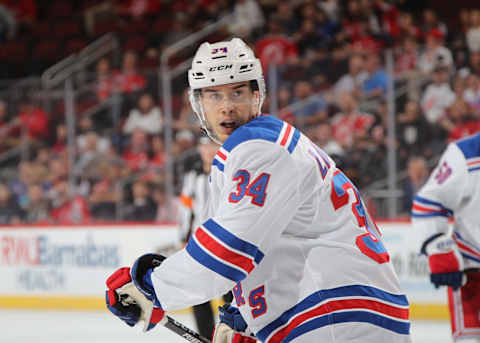
10. Michael Lindqvist, RW [24] (UDFA)
Stats (Farjestad BK, SHL): 33 gp, 20 g, 14 a, 34 p, 10 PPG, 4 GWG (2 pgp, 2 g, 1 a, 3 p, 1 PPG).
T-15 scoring, T-6 goal scoring (2nd goals/game), 5th pts/g; 1st playoff pts/g, T-64 scoring, T-32 goals
Michael Lindqvist is an excellent goal scorer, someone who took over the SHL, even in a shortened season, and made a huge impact. He was the goal-scoring menace on Farjestad BK that took the team far and was tied for sixth in goal scoring in just 33 games. He was second on the team in goals per game. Even with 10 of those goals coming on the power play, that was an impressive season from the Swede.
Michael Lindqvist is an excellent goal scorer, someone who took over the SHL, even in a shortened season, and made a huge impact
Lindqvist was also first in points per game in the playoffs with more than one appearance, scoring a goal per game. Even in just two games, Lindqvist was tied for 32nd in goals in the SHL playoffs. Lindqvist had four game-winning goals in the regular season and was tied for 15th in point production, fifth in points per game. Those are impressive numbers, and he should be shaping up for a good position in the NHL.
The biggest problem with Lindqvist is that he’s 24 and has never played in North America. That puts a hamper on his effectiveness at the NHL level, and also on his ceiling. He’s not quite NHL ready, likely starting the year in the AHL, and will need to prove himself at that level first. He needs to score a few goals and get used to competing against players of his calibre and better. Then he could make a useful middle-six goal scorer.
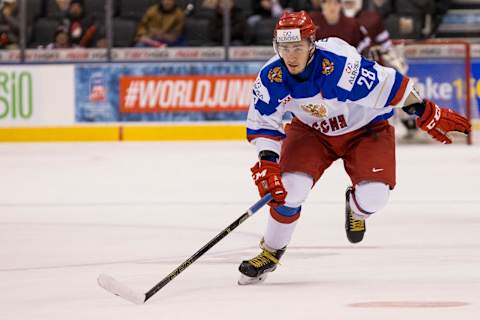
9. Yegor Rykov, D [21] (5-132, 2016)
Stats (SKA St. Petersburg, KHL): 53 gp, 2 g, 12 a, 14 p (13 pgp, 0 g, 2 a, 2 p);
Stats (SKA-Neva St. Petersburg, VHL): 7 gp, 0 g, 6 a, 6 p (8 pgp, 1 g, 1 a, 2 p).
A good defensive defenseman who didn’t have the best offensive numbers in the KHL this past season, Yegor Rykov is shaping up to be a future member of the New York Rangers’ blueline. He was tied for 56th in defensive scoring in Russia, adding just two goals and 14 points in 53 games. Again, not the greatest numbers. But Rykov is one hell of a defenseman in his own zone, and at 6’2″ has the power to push forwards out of the dirty areas. That’s what the New York Rangers should be looking at this season in terms of what Rykov does.
Rykov is one hell of a defenseman in his own zone, and at 6’2″ has the power to push forwards out of the dirty areas
Rykov, of course, has some offensive value. He was near a point-per-game pace in the VHL, Russia’s second league, despite not scoring a goal until the playoffs. Between the two leagues, Rykov played in 21 playoff games. He played consistent minutes with one of the best teams in the KHL, including in the postseason. Rykov is a hell of a defensive force, which is why he gets on this list without offensive numbers.
He’ll have a tough path to the NHL and needs to prove himself in North America. The Rangers can’t have as many eyes on him in the VHL as they can in the A, and that’s why he’ll need to transition. Even if it turns out he’s an excellent defensive defenseman on North American ice, Rykov is still a few years away from the NHL. He’s back in Russia this season, and right now it doesn’t look like he’s got the highest likelihood of playing consistently with the Rangers.
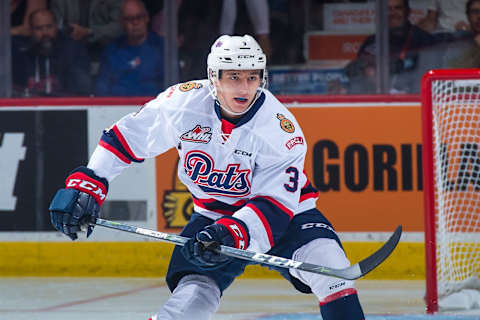
8. Libor Hajek, D [20] (2-37, 2016)
Stats (Saskatoon Blades/Regina Pats, WHL): 58 gp, 12 g, 27 a, 39 p, 3 PPG (10 A), 1 GWG, 144 SOG, .67 pts/g (4 pgp, 1 g, 0 a, 1 p, 1 PPG, 1 GWG, 13 SOG, .25 pts/g).
Libor Hajek was the centerpiece of the Ryan McDonagh return, or so we’ve been led to believe. For a centerpiece, Hajek isn’t great, at least not offensively, with the numbers available. Hajek scored far less than a point-per-game in the WHL and was actually 27th amongst WHL defensemen in scoring. He missed a good number of games, but he was still just tied for 20th in points per game. He’s not an elite offensive defenseman.
He’s got great defensive instincts, understanding how to shut down passing lanes and where to position himself to make the play
What Hajek is good at is defense. He’s a solid defensive presence, likely a better one than Rykov, and he has a lot of size, standing at 6’2″, and he has mobility. He’s got great defensive instincts, understanding how to shut down passing lanes and where to position himself to make the play.
The Regina Pats, the team that traded for Hajek at the deadline in the WHL, lost in the first round of the WHL playoffs but came in second in the Memorial Cup. That might be, in part, because of the defensive efforts of Hajek and the other blueliners. The Pats only allowed two goals in the first playoff game against Hamilton before allowing three in the championship game.
Hajek will make the professional transition this season to Hartford. He needs to show the Rangers that his skill set will translate well to the pro game. He’ll have plenty of opportunity to do so, likely getting top-four minutes to start off and expanding his role depending on how he plays. This should be a year to watch for the young defensive prospect, and more eyes should be on Hartford.
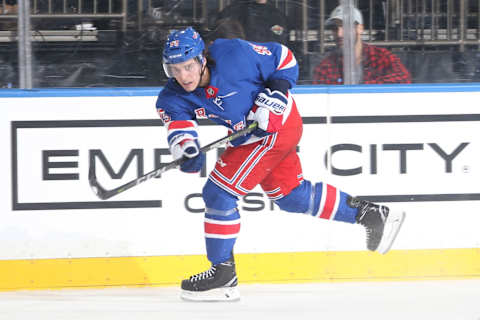
7. Vinni Lettieri, RW [23] (UDFA)
Stats (Hartford Wolf Pack, AHL): 55 gp, 23 g, 13 a, 36 p, 9 PPG (3 A), 2 GWG, 2 ENG, 142 SOG, .65 pts/g
Stats (New York Rangers, NHL):19 gp, 1 g, 4 a, 5 p, 1 PPA, 28 SOG, 12:03 TOI, .26 pts/g.
Vinni Lettieri has been trying to bust into the NHL for the last few years. At 23, he’s still young and capable of making an impact. At the NHL level, Lettieri appears to be a third-line goal scorer, somebody who adds depth scoring on a consistent basis but isn’t good enough to take over the game. In 19 games with the New York Rangers last year, Lettieri had five points, including just one goal. He’s better than that, coming in tied for 24th in goal scoring despite playing 20 fewer games than his competition.
At the NHL level, Lettieri appears to be a third-line goal scorer, somebody who adds depth scoring on a consistent basis but isn’t good enough to take over the game
Lettieri was at about a .5 goals per game pace in the AHL and was excellent on the power play. He scored two game-winning goals and two empty netters. Lettieri also had good shot production, which at the professional level means 2.58 shots per game. He also did very well in the NHL, even with limited time, producing at a 1.47 shots-per-game rate.
Lettieri is actually very close to being in the NHL consistently, is NHL ready, and stands a very good chance of playing for the New York Rangers. The only reason he’s not higher on this list is his ceiling, which isn’t very high. The six guys in front of Lettieri have way better ceilings and should have a larger impact on the Rangers in the future.
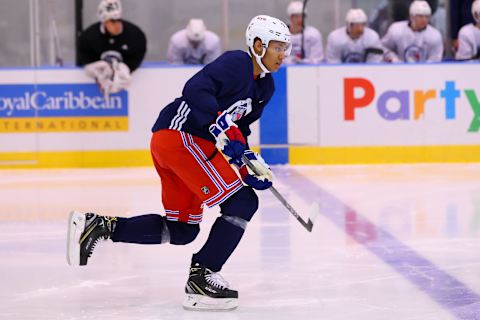
6. K’Andre Miller, D [18] (1-22, 2018)
Stats (USNTDP Juniors, USHL): 22 gp, 4 g, 12 a, 16 p, 1 PPG (1 A), 1 GWG, 48 SOG, .73 pts/g; 58 gp, 9 g, 20 a, 29 p, 2 SHG, 2 GWG, 103 SOG, .5 pts/g. US National U18 Team, USDP
T-206 scoring [USHL]; T-27 scoring, T-20 assists, T-25 goals, T-89 pts/g [USDP]
K’Andre Miller was an excellent defensive prospect this season and projects as a top-four defenseman. He’s recently converted from a forward and has actually gripped the defensive fundamentals quicker than he has scoring from the blueline. He’s got all the size in the world, moves well, and has dynamic instincts that allow him to shut down plays and get players out of the dirty areas. It’s perhaps because he was a recent convert that he has those instincts – he understands the opposing forwards’ games and knows how to shut them down.
K’Andre Miller was an excellent defensive prospect this season and projects as a top-four defenseman
There’s a lot to like about Miller’s game. He did well in both the USHL and the USDP this past season, one of the best defensemen in both leagues. He had two shorthanded goals in the USDP and had good shot production. He won’t score as many points in the NCAA this next season as the New York Rangers would like to see, but again, he’s still growing his offensive game. It’s the sophomore season where Miller will need to prove himself.
He’s still a few years away from being an impact player in the NHL. He’ll get good time in the NCAA with the University of Wisconsin against stiff competition like the University of Minnesota and the University of Minnesota Duluth. He’ll make an AHL transition eventually, and should prove to have grown enough as a defenseman to make an impact at that level, and then at the NHL. He’s a future top-four defenseman and should watch a lot of Dustin Byfuglien footage in the coming years, as that’s the ideal for what Miller can be.
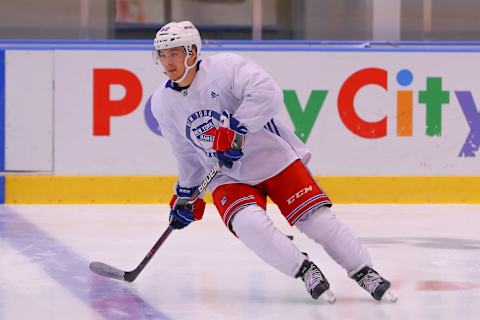
5. Ty Ronning, RW [20] (7-201, 2016)
Stats (Vancouver Giants, WHL): 70 gp, 61 g, 23 a, 84 p, 18 PPG (6 A), 2 SHG, 9 GWG, 339 SOG, 1.20 pts/g (7 pgp, 1 g, 6 a, 7 p, 33 SOG, 1 pt/g).
Ty Ronning is one of the greatest goal scorers to have gone through the WHL in the past decade. At a nearly goal-per-game pace throughout last season, Ronning was one of the greatest goal scorers in the league. He was second in goals behind only Jayden Halbgewachs, who is a half-year older and played with a better team. Ronning was one of the players who carried the Vancouver Giants and was a huge part of their getting to the playoffs.
Related Story. Each Team's Worst Contract. light
Ronning wasn’t as good in terms of assists, but every team needs a pure goal scorer more than they might realize. Ronning was tied for 24th in regular season scoring in the WHL and 32nd in points per game. In the playoffs, he was tied for 45th in points per game and 65th in scoring, playing just seven games and going point-per-game through them. Ronning was also excellent in terms of shot production, averaging 4.84 shots per game. The best goal scorers are often volume shooters, and Ronning is no exception.
Ronning’s biggest weakness is his size, just 5’9″. But that’s no longer something that holds players off from the NHL, and he should be bound for a roster spot with the Rangers. As an elite goal scorer in the Canadian juniors, Ronning should eventually hit a ceiling of a top-six goal scorer. So why is he so low? Because he’s still a few years off from the NHL and there’s less of a guarantee he plays for the Rangers than the prospects ahead of him.
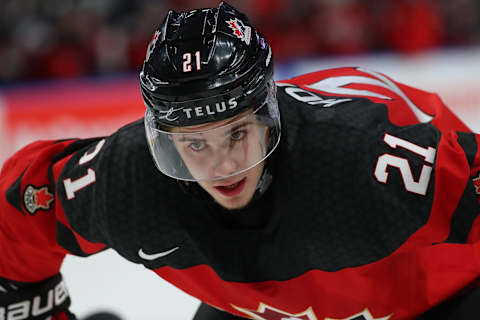
4. Brett Howden, C [20] (1-27, 2016)
Stats (Moose Jaw Warriors, WHL): 49 gp, 24 g, 51 a, 75 p, 5 PPG (18 A), 2 SHG (3 A), 5 GWG, 141 SOG, 56.4 FO%, 1.53 pts/g (14 pgp, 7 g, 8 a, 15 p, 2 PPG (3 A), 1 GWG, 42 SOG, 54.3 FO%, 1.07 pts/g).
Brett Howden played only about half a season in the WHL. Still, he was tied for 38th in scoring and was 12th in points per game. He’s an incredible goal scorer, a terrific playmaker, and someone who can help the goal-scoring wings in the system flourish. If Howden and Ty Ronning are on the third line for the New York Rangers in the future, that means two things. One, that the Rangers have two excellent lines in their top six, and that the Rangers will have a lot of depth scoring.
light. Related Story. Greatest NHL Players to Wear Each Number
Howden was a part of the return for McDonagh, and right now is a better prospect than Hajek. He was good on both the power play and penalty kill and has the ability to shoot in spurts (averaging 2.88 shots per game), scoring a good amount of goals for doing so. In the playoffs, when Howden was fully healthy, he was tied for 23rd in scoring, 18th in goals, and 40th in points per game. He stayed above a point per game and averaged three shots on goal. Howden was one of the main driving forces for the Moose Jaw Warriors, who did very well in the WHL playoffs.
Howden isn’t entirely NHL ready, but he’ll be able to transition to the AHL this season to get in a better position. He also doesn’t have that high of a ceiling with the New York Rangers, likely having to settle for a third-line role, as the Rangers have Filip Chytil and Lias Andersson ahead of Howden on the organizational depth chart. Still, Howden is a massively talented prospect and someone who could change the Rangers’ bottom six.
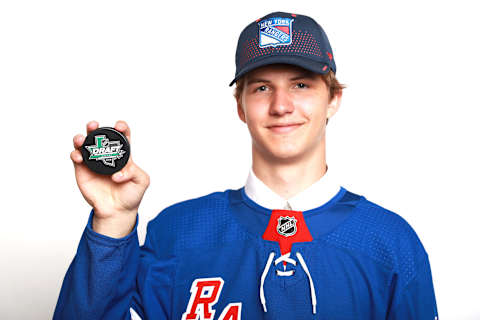
3. Vitaly Kravtsov, RW [18] (1-9, 2018)
Stats (Traktor Chelyabinsk, KHL): 35 gp, 4 g, 3 a, 7 p (16 pgp, 6 g, 5 a, 11 p); 9 gp, 4 g, 3 a, 7 p. Chelmet Chelyabinsk, VHL; 1 gp, 1 g, 2 a, 3 p (2 pgp, 1 g, 3 a, 4 p). Belye Medvedi Chelyabinsk, MHL
Vitaly Kravtsov didn’t have the greatest year in terms of pure numbers. Not getting above ten points in any of the three leagues he played in, playing just 45 games, scoring just nine goals. That’s a function of the transitions he had to make, going from the KHL to the VHL to the MHL throughout the season. He played 18 playoff games, however, and that’s where he really shined, with 15 points in those 18 games.
One Reason Each Team Should Be Excited Next Season. light. Related Story
Kravtsov is an impressive wing, even despite those missing numbers. He played 35 regular season games in the KHL, the second-greatest league in the world, and was a key part of a Conference Finals run for Traktor. Kravtsov also won the KHL’s rookie of the year for his campaign in both the regular and postseason, but especially the postseason. He’ll get an extended look in the KHL this season, and if he does well in professional hockey, he’ll most likely make the transition straight to the New York Rangers.
No matter who’s the future first line center of the Rangers, they’ll need a great right winger. That should be Kravtsov, who has the potential to be a first-line winger, someone who can add both goals and assists. He’s in the mold of the other great Russians in the NHL now, and while he’s not at that take-over-the-game level of an Artemi Panarin or Alex Ovechkin, at least not yet, but Kravtsov could be something special.
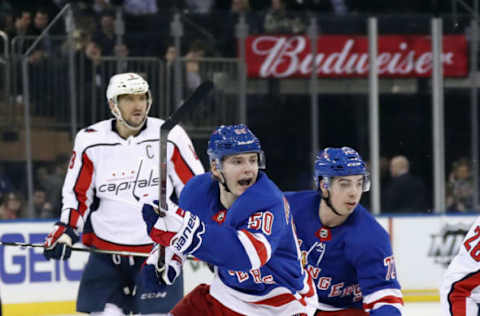
1B. Lias Andersson, C [19] (1-7, 2017)
Stats (Frolunda HC, SHL): 22 gp, 7 g, 7 a, 14 p; 25 gp, 5 g, 9 a, 14 p, 2 PPA, 42 SOG, .56 pts/g. Hartford Wolf Pack, AHL; 7 gp, 1 g, 1 a, 2 p, 5 SOG, 40.4 FO%, 11:57 TOI, .29 pts/g. New York Rangers, NHL
1A. Filip Chytil, C [19] (1-21, 2017)
Stats (Hartford Wolf Pack, AHL): 46 gp, 11 g, 20 a, 31 p, 2 PPG (4 A), 3 GWG, 110 SOG, .67 pts/g; 9 gp, 1 g, 2 a, 3 p, 21 SOG, 36.8 FO%, 13:37 TOI, .33 pts/g. New York Rangers, NHL
It’s too difficult to decide between Lias Andersson and Filip Chytil at this point. They’re both excellent prospects with very similar ceilings, with the potential to run the first or second line. One of them will take one line, the other the other. Chytil was drafted after Andersson, but impressed with a larger opportunity in North America. Chytil scored 31 points, including 20 assists, in 46 AHL games, in his first post-draft season. He also got nine games with the New York Rangers, scoring three points. He’ll need to work on faceoffs, however.
Andersson has the same problem with faceoffs but was better than Chytil. He only got seven games in the NHL, scoring two points, and being outshot by Chytil as well. Andersson did very well in the SHL before making the transition in his first year, a harder transition than Chytil made. But Andersson still has a lot of potential, and there’s a reason the New York Rangers took him seventh overall just a year ago. He has the better potential of the two, but right now, Chytil is more NHL ready.
Next. 3 Reasons for Optimism for the Rangers. dark
Both of these players are crucial to New York’s rebuild. They both look to be future Blue Shirts and have already made their professional debuts with the team. They both might need a bit more seasoning and are not ready for a full-time top-six job. Andersson might get the first-line role in Hartford this season. Chytil might be the third-line center for the Rangers, playing behind Mika Zibanejad and Kevin Hayes. Both players should assume less pressure this season, but as they improve, they should become the Rangers’ future top-six anchors.